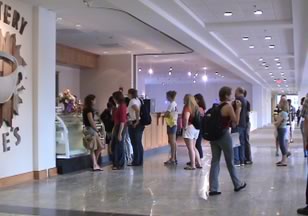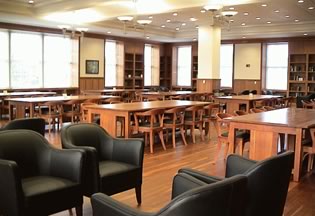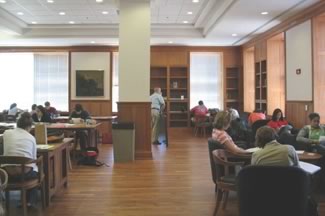Chapter 41. University of Georgia: Student Learning Center
What Is It?
The Student Learning Center (SLC) [archived: http://www.slc.uga.edu/] at the University of Georgia (UGA) opened in August 2003. Encompassing more than 200,000 square feet, it integrates general classrooms with an extensive electronic library or information commons. (See Figure 1.)
Figure 1. Student Learning Center

Led by the university architects [archived: http://www.maps.uga.edu/] and Cooper Carry, the design architect, several university departments collaborated on the design of the facility and continue to service it: the University of Georgia Libraries; the Center for Teaching and Learning (CTL), which provides classroom support and instructional support for faculty; and Enterprise Information Technology Services (EITS), UGA's computing services. Other partners include the Office of the Vice President for Instruction and the Office of the Vice President for Student Affairs.
Geared toward undergraduates, the SLC consists of two interlocking components: classrooms and the Electronic Library.
The classroom component, managed by the CTL, includes:
- 26 general classrooms varying in size from 24 to 300 seats, with a total of 2,200 seats
- Offices for staff who support the classrooms
- An interactive computer lab dedicated to faculty technology development
- Three faculty preparation rooms providing a work space away from the faculty member's office
The Electronic Library, managed by the UGA Libraries and EITS, includes the following:
- 2,300 seats in a variety of configurations, including single- and double-carrel seating, study tables and chairs both in and outside a group study room, soft seating, and four computer labs
- Three state-of-the-art computer classrooms dedicated to teaching electronic research, information literacy skills, and technology
- 500 PC workstations
- 96 group study rooms with 6 to 10 seats each
- A pervasive wireless network and 2,000 data ports
- A traditional reading room for quiet study
- Four information/reference desks
- A coffee shop (see Figure 2)
Figure 2. Jittery Joe's Coffee Shop

The SLC is comprised of four floors of approximately 50,000 square feet each. The building is designed to integrate the two components (classrooms and the Electronic Library) so that students can quickly shift from classroom activity to research or study. Floor plans are located at <http://slc.uga.edu/facility.html#floorplans>. Photos of the SLC and a QuickTime video are available at <http://slc.uga.edu/press/educause.html>.
The first state-chartered university in America, UGA is a research institution with approximately 24,814 undergraduate and 8,386 graduate/professional students. Fifteen colleges and schools, with auxiliary divisions, conduct the university's programs of teaching, research, and service.
What Happens Here?
The classrooms are equipped with state-of-the-art presentation technology and computers. The CTL Classroom Support Center in the building provides support for classroom technology. The CTL's other units also provide workshops and seminars on various teaching technologies for faculty and teaching assistants.
The Electronic Library offers access to 500 research databases and 30,000 full-text journals and newspapers. Microsoft Office and other course-specific software programs are available on each of the 500 PCs, with additional Web design software on 20 multimedia PCs. Research, reference, and computing help are available at four information desks in the building. Because of the integrated nature of the classroom and library environment, librarians at the SLC have an unusual opportunity to promote information literacy. EITS also offers courses in various software packages to the general student population.
Currently under design, a digital media lab will provide students with workstations, media, and Web development software as well as on-site support and training to help them create their own digital multimedia projects for courses. The UGA Writing Center offers on-site walk-up services [archived: http://www.slc.uga.edu/students.html#writing] that have proven to be very popular. The UGA Tutorial Program also takes advantage of the facility by offering free tutoring in core-level math, science, language, and business courses by appointment and on a drop-in basis.
After 5:00 p.m., the SLC classrooms are heavily booked as meeting spaces for registered student groups and campus departments, and several areas in the SLC can host events [archived: http://www.slc.uga.edu/policy/eventspace.html] that encourage collaboration between faculty and students or allow departments to host small conferences, presentations, or speakers. The SLC has become a host site for freshmen and transfer orientation sessions held throughout the summer featuring parent receptions, testing, and course registration.
The SLC offers a light-infused environment with comfortable seating, student-focused services, and an open food and drink policy. Feedback from faculty and students is that Jittery Joe's Coffee Shop, the group study rooms, the open table environment, and the soft seating areas promote both informal discussions and study sessions.
How Is Technology Used?
The building uses technology to offer research, teaching, and computing services in an integrated learning environment. More than 500 PCs are provided as well as a pervasive wireless network and more than 2,000 physical connections. Technology is also used for building monitoring, including automated access control, motion detection, and lighting control.
Each classroom is equipped with state-of-the-art presentation technology. With its classroom control software, CTL can maintain, monitor, and assess all classroom equipment use centrally.
More information is available at [archived: http://www.slc.uga.edu/facility.html#technology].
What Makes the Space Successful?
The SLC provides a one-stop shop with classrooms and library research sources located in one facility. In addition, the computer software and technology create a common interface. Based on usage alone, we believe the space is successful. Approximately 8,000 students use the facility a day, with 1.5 million visitors in 2005. Even UGA's president noted that the SLC is "now truly the signature academic building on campus, filled at all hours with students, faculty, and staff engaged in the full range of academic activity."1
Part of the integration of the SLC comes from a new focus on the library as "process." The SLC integrates learning in class, gathering information, and consulting with research professionals, using SLC computers to complete assignments or a group study room to practice a presentation. The SLC gives faculty and students the opportunity to teach and to learn in a technology-enhanced environment.
The simple building design with light-filled, open spaces, and student/faculty-driven policies and protocols creates a pleasant environment. Advanced technology combined with traditional library furnishings such as solid cherry tables and chairs by Thos. Moser Cabinetmakers [archived: http://www.thomasmoser.com/library/] invites students to linger. (See Figure 3.) In addition, the space is flexible. Classrooms can be used in the evenings for student meetings, tutoring, or other activities, and the building has become a location of choice for a variety of student pursuits. Flexibility is built into the design; the space can adapt to new user needs as they arise.
Figure 3. SLC Reading Room (a) Furniture and (b) in Use
(a)

(b)

The building partners' shared oversight and collaboration has created a solid management and operations structure to guarantee that the building continues to serve student and institutional needs. In addition, SLC staff training, a clear service philosophy, and performance expectations ensure that student needs are met and the facility is well utilized. Success is further measured by a formal assessment process that involves student input via structured focus groups. Informal assessments include on-site observation of how students use the space, soliciting suggestions, unsolicited suggestions to our SLC e-mail box, and letters to the editor in the school newspaper.
What Principles Were Behind the Design?
Four principles informed the design:
- Integration: The SLC was designed to integrate services, both online and physically. For example, great emphasis was placed on integrating classrooms, technology, and the Electronic Library.
- Adaptability: The SLC adopted a 50-year building concept that begins with a basic structure but assumes it will change as needs change.
- Centrality: A location in the center of campus makes the SLC both a place to move through and a place to move to on campus.
- Collaboration: The SLC provides spaces that encourage group study and allow group work on projects.
What Is Unique or Noteworthy?
To our knowledge, the SLC is the only facility at a research university to combine a large number of general classrooms with the information commons concept. The university architects coordinated the building program and sought input from many campus units while working closely with the building partners, which ensured buy-in and knowledge of the building from all constituencies who would be using the building and led to it being viewed as a university-wide resource rather than one controlled by any single department or unit. The SLC offers general classroom space to all disciplines; thus, students and faculty alike have the opportunity to interact with colleagues who they might not normally see.
According to UGA President Michael F. Adams:
The opening of the Student Learning Center may have had the greatest impact on the intellectual climate of this institution since Old College was constructed (in 1806).... Every time I am there the place is alive with academic activity.… I do not know of another facility on this or any other campus where design so fully meshes with function.... For decades to come, the Student Learning Center, with its combination of Electronic Library and classroom spaces, will be a defining experience for almost all UGA students.2
Endnotes
- University of Georgia President Michael F. Adams, "2005 State of the University Address," January 13, 2005, <http://www.uga.edu/presofc/pdfs/speeches/SoUGA2005.pdf>.
- University of Georgia President Michael F. Adams, "2004 State of the University Address: A Community of Learners," January 15, 2004, <http://www.uga.edu/columns/040120/news13.html>.
About the Authors
William Gray Potter is the university librarian and associate provost, Main Library, University of Georgia Libraries, University of Georgia.
Florence E. King is the assistant university librarian for human resources and director, Student Learning Center Electronic Library, University of Georgia Libraries, University of Georgia.